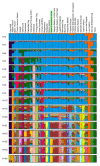Genomic Characterization of the Istrian Shorthaired Hound
- PMID: 33139624
- PMCID: PMC7693797
- DOI: 10.3390/ani10112013
Genomic Characterization of the Istrian Shorthaired Hound
Abstract
Istrian shorthaired hound is an old indigenous Croatian dog breed with historical traces of its origin, which date back to the 14th century. Due to its intelligence and great hunting abilities, it is considered an excellent hunting dog. Despite its ancient origin, there is no data on genetic diversity, population structure, and degree of inbreeding that could be used for advanced management and conservation of this breed. Our study aimed to provide a high-resolution population structure of the Istrian shorthaired hound using a 220K HD SNP array, to compare the obtained data with the genealogical records and to place the breed in a broader context of world dog populations. Relatively high population size and low inbreeding coefficient estimated from genealogical data indicate a preserved genetic diversity in this breed. The principle component analysis, the NeighborNet network, and TreeMix were used to determine the genetic relationship between the Istrian shorthaired hound and other breeds. The Istrian shorthaired hound was found to be genetically related to Italian hunting dogs sharing the same branch with the Segugio Italiano a Pelo Raso and Segugio Italiano a Pelo Forte. The ADMIXTURE analysis indicated that the Istrian shorthaired hound could be involved in the development of some other hunting dog breeds. The estimated effective population size (Ne) based on SNP data was similar to Ne calculated from genealogical data indicating the absence of bottlenecks and well-balanced use of breeding animals. The low genomic inbreeding coefficient, together with the higher number of short runs of homozygosity, observed in the Istrian shorthaired hound, confirms the ancient origin of the breed based on historical documents. The analysis of selective sweeps identified genomic regions with the strongest selection signals in the vicinity of the genes associated with cognitive performance and behavior. Genome analysis proved to be a useful tool for estimating population parameters and can be implemented in the conservation plan for this indigenous breed.
Keywords: Istrian shorthaired hound; SNP array; genealogical data; genetic diversity; population structure.
Conflict of interest statement
The authors declare no conflict of interest. The funders had no role in the design of the study; in the collection, analyses, or interpretation of data; in the writing of the manuscript, or in the decision to publish the results.
Figures










Similar articles
-
Genetic Diversity of Bosnian and Herzegovinian Autochthonous Dog Breed Bosnian Broken-Haired Hound-Barak.Biochem Genet. 2023 Jun;61(3):901-915. doi: 10.1007/s10528-022-10291-8. Epub 2022 Oct 13. Biochem Genet. 2023. PMID: 36229562
-
The German Shorthair Pointer Dog Breed (Canis lupus familiaris): Genomic Inbreeding and Variability.Animals (Basel). 2020 Mar 17;10(3):498. doi: 10.3390/ani10030498. Animals (Basel). 2020. PMID: 32192001 Free PMC article.
-
Genomic characterization of the Braque Français type Pyrénées dog and relationship with other breeds.PLoS One. 2018 Dec 5;13(12):e0208548. doi: 10.1371/journal.pone.0208548. eCollection 2018. PLoS One. 2018. PMID: 30517199 Free PMC article.
-
Kazakh national dog breed Tazy: What do we know?PLoS One. 2023 Mar 8;18(3):e0282041. doi: 10.1371/journal.pone.0282041. eCollection 2023. PLoS One. 2023. PMID: 36888576 Free PMC article.
-
Genome-wide diversity and runs of homozygosity in the "Braque Français, type Pyrénées" dog breed.BMC Res Notes. 2018 Jan 9;11(1):13. doi: 10.1186/s13104-017-3112-9. BMC Res Notes. 2018. PMID: 29316964 Free PMC article.
Cited by
-
Pedigree and Molecular Analyses in the Assessment of Genetic Variability of the Polish Greyhound.Animals (Basel). 2021 Jan 31;11(2):353. doi: 10.3390/ani11020353. Animals (Basel). 2021. PMID: 33572519 Free PMC article.
References
-
- Romić S. Uz 470. godišnjicu ergele đakovačke. Zb. Muz. Đakovštine. 1978;1:27–39.
-
- Croatian Kennel Club Croatian Kennel Club—Ilica 61, HR—10000 Zagreb. [(accessed on 9 October 2020)]; Available online: http://webeng.hks.hr/
-
- Pasarić O. Master’s Thesis. Josip Juraj Strossmayer University of Osijek; Osijek, Croatia: 2018. Breeding Characteristics of Croatian Hunting Dog Breeds on the Territory of Croatia.
-
- Zajc I., Kus M. Populacijska struktura dalmatincev in istrskih gonicev ter njihovi evolucijski odnosi z nekaterimi drugimi pasmami, kot jih nakazujejo polimorfni mikrosateliti = Population structure of Dalmatians and Istrian shorthaired hounds and their evolutionary relationships to some other breeds as revealed by polymorhic microsatellites. Slov. Vet. Res. 2001;38:35–43.
Grants and funding
LinkOut - more resources
Full Text Sources

